|
Born in early April 2011, abandoned or lost in early June 2011, found wandering along the road June 4, 2011 and turned in at Safe Harbor in Jackson that day. I heard about her on July 12, and by 16:30 that day, she was in my custody, and on her way to a life of service.
She was described on the adoption paper as a yellow Lab mix, but since she has no extraneous markings, and her tongue is pink (no black marks), and she has the requisite webbed feet, I am an hopeful there is more Lab than "mix" in her genes.
The ride home was uneventful, with her asleep in Janice's arms the whole way. She rides very well, an excellent first sign.
The name given her at Safe Harbor was "Biscuit" but, while that might be cute for a puppy, in later years I couldn't see introducing her as "This is my search dog, Biscuit." So I changed her name to Duchess, and she now responds to that name more often than not.
Her initial visit to the vet revealed no serious infestations, apart from several scabs from tick bites, which Dr. Branscom at Tilsit Road Animal Clinic pronounced non-life-threatening. He said she is a sound little dog, that will be of some significant size if the current foot to body size ratio is to be believed.
Among the joys of training a new dog is the fact that you get a do-over, from previous dogs, and you can avoid mistakes. knowing what the result will be if they are repeated.
Our first night together, I slept in a chair, and Duchess slept in my lap. We were bonding. However, from previous experience, I know that this can not be allowed to go on, especially with a dog that will get to be 50-60 pounds. So the next night, Duchess slept in her crate, not a peep.
This will be the norm. The crate will be used as intended, as a private place for her to find sanctuary where ever we go. This is a major thing in a dogs life and I didn't really realized the importance until Lady got too big to unscrew that particular mistake I made with her.
Duchess seems to be taking to "home crate" pretty well:
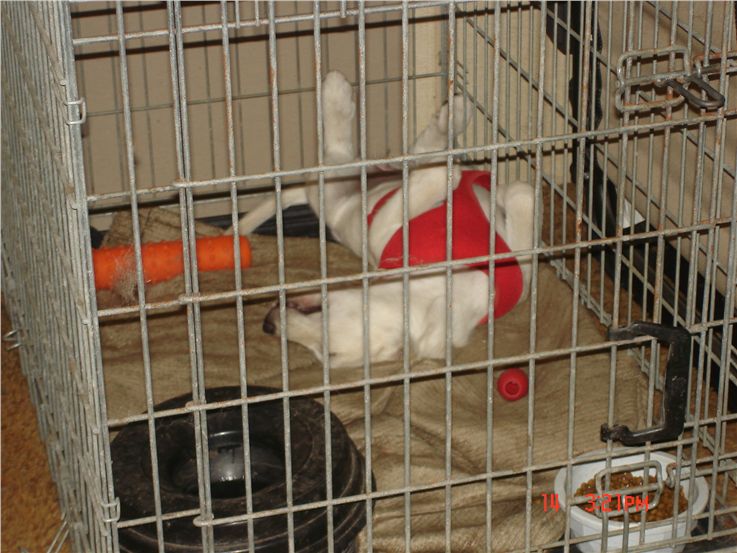
Another curse is those sharp little teeth and the need to chew. I already have a new set of scratches and marks on my hands and arms from fending off the playful sparing. All wiring and other human articles that we don't want chewed are out of reach.
Potty training is going well, as long as I remember to take her out every time she wakes up, every time she eats, and every two hours in between. And, pay attention to unwarranted sniffing and serious place hunting any other times.
She took to the lead very quickly, with a minimum of tugging and pulling, and she now walks around off lead outside most of the time, coming when called more often than not. The exception is when Gizmo is around. He likes to lead her astray, and she can't resist.
We are on our way to having another search dog. This beginning imprinting time is as important as the actual search training to come later, because it sets the stage for obedience. Obedience is the basis of all training, and if the imprinting period is done correctly, the obedience phase comes a lot easier and provides that sound basis with a minimum of "unlearning" of bad habits to be done.
Now to the human aspect of this email. If this is boring to you and you'd just as soon not have your email cluttered up with messages like this one. Say so, and I will not send them to you. I recognize that not everyone is a dog person, as there is no accounting for taste in some folks.
I like to share this information, since for the foreseeable future my life will be inextricably bound to this little dog, and involved in Lady's recovery from her thyroid problems. The new vet has changed her medication and assures me that she is likely to recover, lose the extra weight, and give us a couple more years of service. Heart and lung sounds are good and other blood work looked good.
As they say, it is what it is.
Shots Fired 7/17.2011
One of the first things we do during the imprinting stage is to introduce our "trainees" to gunfire. In a fugative search, it is imperative that the dog not bolt at the sound of sudden loud noises. Much like a hunting dog, a search dog cannot be distracted by its environment, and that includes loud noises.
We chose the Open Range Day at BTS to expose Duchess to this element.
Keeping her 50 yards from the firing line, we allowed her to just mill around, on lead, until the firing started. When she started and looked in the direction of the noise, we moved close to her, reassured her, praised her (for not heading for the next county at the first loud noise) and simply played with her while the shooting continued.
We repeated this for the first few strings of fire, and as time went by, she was paying less and less attention to the noise.
Then we just let her alone while the firing was going on, and she was more concerned with digging herself a cool spot in the shade to lay in, than with the noise.
Finally she began to nap, and slept through the rest of the afternoon even when some rifles were brought out, which are much louder than the handguns.
Duchess also got some quality socialization time with the others attending Open Range, another key element during imprinting is to introduce her to as many friendly human and canine contacts as possibly. This is not really a training goal as much as a it is taking advantage of the imprinting period to develop the personality you want the dog to have the rest of her life.
Exposure to positive experiences, while being sheltered from unnecessary negative experiences is the key.
This is not to say that you don't allow enforcement of pack discipline and manners. This is the advantage of having an older, experienced dog involved in process. Lady is not bashful in explaining to Duchess when she has crossed the line into unacceptable behavior. And, while I don't really speak dog, Lady's corrections of Duchess with regard to climbing on the senior's back, nipping ears and jumping in one's face seemed to require only a sharp, abrupt dog language correction, and the behavior is not repeated. Duchess does not appear intimidated by these corrections, because she most often will create some distance from Lady and turn and yap something back in reply. But she does not repeat the behavior.
Another successful training day.
Some learning is best presented by another dog. 07/18/2011
This is sub titled, "You can do what with water?"
All Labs love water, right. That depends on how they were first introduced to it.
If during the imprinting stage, their first experience with water was terrifying or painful, they can very easily shy away from getting into it, which can translate into a major distraction for the search dog later in training.
The trainer's main task during the imprinting stage is to assure that the trainee's first experience with essential elements is pleasant and fun so that acceptance is a natural event.
Some things are best introduced to the trainee by a collegue, a mentor, a trusted member of the species.
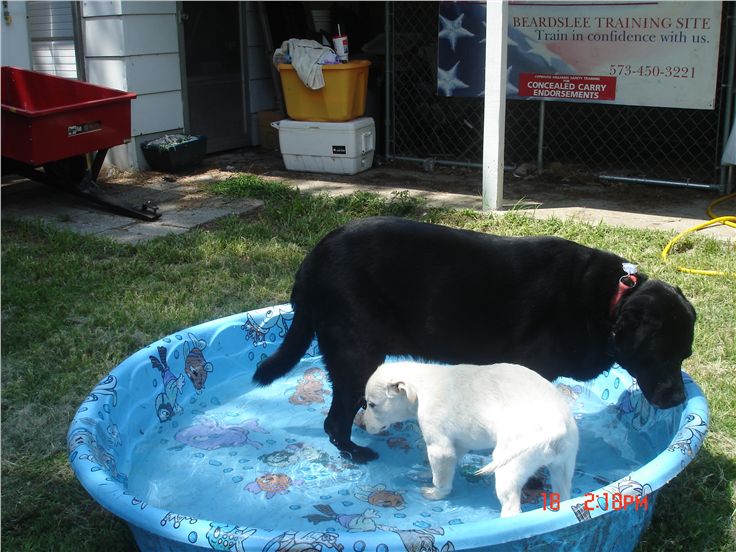
Since Duchess was not sure of the reason she should just jump into a pool of water, Lady was glad to show her what else water is good for besides drinking.
If she follows Lady into the pool, it is her idea, and not mine. So there is no force on the part of the human to make her do anything she doesn't want to, making her wide open to enjoy and appreciate the wonders of water as most Labs do.
Before long, she is self-initiating without encouragement or direction from anyone.
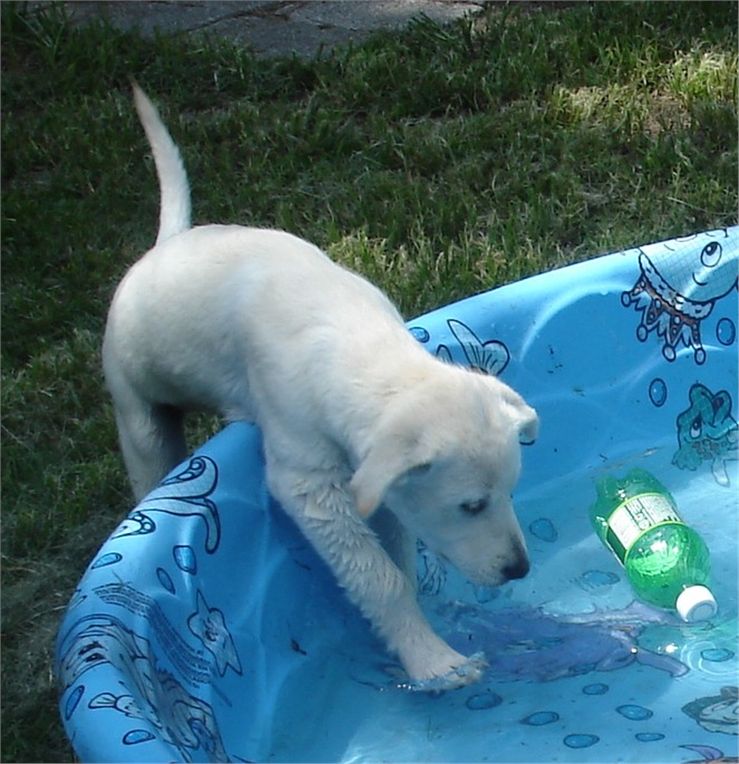
At this point you let them play with the new found wonder until they lose interest and go on to something else.
Once she is completely at home in water, we make it deeper, until she is swimming, the final goal. Dogs do not need to be taught to swim. they get that in Home Womb, but it is the association with water that requires a bit of planning and patience.
Of course, there are those out there who would say, "Aw, just pitch her into a pond, she will swim out."
Probably so, but if you are trying to develop a dog on whom you can rely 100 percent of the time, under all conditions, I think the extra effort is well worth the time and patience required.
If the estimate of her age is correct, this week would be her 18th week, and just beyond the theoretical end of the "Imprinting Period."
Although, we have missed this critical period by a few weeks, I have tried to take advantage of the theory as much as I could, for the short time I have had Duchess with me. She appears to me to be very well adjusted, outgoing and inquisitive without any serious fears.
We will just have to trust to luck. I was certainly lucky to find her, and she was lucky nothing serious happened to her while she was wandering on her own at such a tender age. She was lucky the good folks at Safe Harbor took her in and took such good care of her. Then, there was the luck of Lisa telling me about her, and me making the decision to start another dog in my advanced years. Finally, we are lucky for her to be of the temperment she is, considering the unknowns that have already occured in her young life. She seems very intelligent, and nearly fearless. There may well be such a thing as Divine Intervention.
Waller Search 7/24/2011
Another event in Duchess' life, her first search, The search for the missing mother from Jackson, brought an opportunity to help out in a worthwhile cause and at the same time expose Duchess to many new people, a couple new dogs, and the search environment in general.
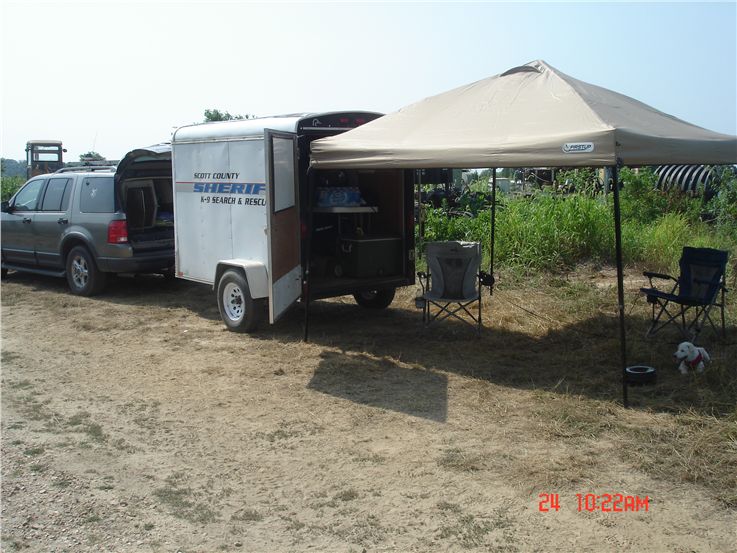
Our job at the scrap yard was to provide heat relief in the form of shade and cold water. Duchess guarded the waterbowl.
Some of Duchess' new friends were the LESAR Team, who let her into their after action photo
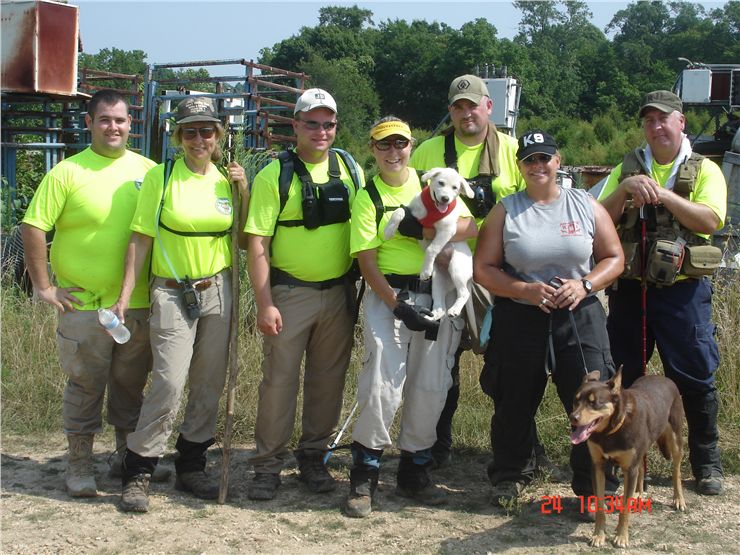
-
A day of socialization and a new experience. A preview of things to come.
Duchess Evolves
The next big event in our life (at six months) was a trip to Tilsit Animal Clinic to be spayed and get our first Rabies shot. That did not register very high on Duchess' list of favorite things to do, but she bounced back very quickly, and I had to keep her away from the other dogs so we wouldn't pop a stitch.
During this quiet two weeks between surgery and getting our stitches removed I find to be a good time to introduce the eCollar. Everytime we go out to potty or exercise, we put the collar on for familiarization and so that it is associated with fun things to do. Also during this quiet time we intensify our marker training, responding to food reward, and associating the reward with the correct behavior and the marker word (I don't like to use a clicker). This does not have to be a wasted time, and can be very productive.
Once the stitches are out, it is time to get serious about obedience. A solid obedience foundation provides meaning and support for all future training, so it is imparitive that it is done correctly. We do that with a long lead. The eCollar is still on, but we don't activate it until a behavior is learned, and she is reliably responding to the food reward, with mild corrections from the lead when necessary.
When she is responding to the commands (meaning that she knows what the command means), we gradually substitute the lead with the eCollar. Establishing a level of stimulation is a bit tricky. You start at the lowest level and let her wander around until you get a reaction when you apply a "nick" looking for a blink of the eyes, and for the dog to look at the ground as if to say "what was that?"
Once you have established this basic level, you should be aware that different things effect that level (at least at the beginning of the training when the dog is new to this type of correction). You cannot use the same level for a dog running that you use for a dog laying on the ground, possibly in wet grass. There is apparently a difference in contact with the ground that can create quite a variance in reaction.
We have to take time with the eCollar. It is a God-send that allows your dog to be off lead and run a play as she is intended to while at the same time you are confident in your ability to control and recall her 100 percent of the time.
Baby steps in this phase will reap huge rewards later.
We will likely be in this obedience/eCollar phase until February or March.

Duchess has a bit of growing, both physically and in training before this vest will fit properly.
I think you have to have a training plan with a dog. It gives order and direction to the things you are doing. Other trainers like to shoot from the hip, and address things as they come up. I find that there is a certain order that should be followed with a dog so that there is less chance of confusing the dog and delaying progress. It also keeps you from forgetting important things, or short changing some areas.
Our training plan calls for us to travel to Extreme K9 at Carbondale, once Duchess' obedience and response to the eCollar are reliable. I want to attend their obedience course and get Duchess' CGC there. Then I want to complete their eCollar course as well, just to make sure we are solid there as well. I wasn't kidding when I said these basics are very important and make all the difference in future training.
Then, they offer a Mantrailing Course we will attend, which is an introductory scent work course. Once she is solid with these skills, and we do many hours and miles of practice at our own training site, here, I will enroll her in the Mega Trailing Course, which, when Lady and I took it, was a six-day event.
Once we successfully complete that, it should be time to go to work operationally. I hope to have all this completed by September, 2012.
That's the plan.
ADJUSTMENTS TO THE PLAN
Since our last entry, there have been a few discoveries which will require some adjustments in Duchess' training. We had been noticing a rotation of Duchess' hind legs, resulting in a decided "Cow Hock" appearance. This concerned us early on, so we had her hips xrayed by Dr. Koch.
Then it came time to go to Extreme K9 for an evaluation of Duchess' suitability for search work.
I was disappointed to learn from them that they felt that the "mix" part of her heritage included Great Pyrenees, and breed that is prone to "Cow Hock" and that this would be a permanant condition with her. They suggested that I have an orthopedic vet evaluate her for soundness and suitability for search work. The folks at Extreme K9 were very nice, and said they would help in any way they could in Duchess' training, in whatever direction I decided to go with it.
We went back to see Dr. Koch, and he confirmed Extreme K9's opinion that Dutch was in deed part Great Pyrenees, and a second look at the xrays showed rotation in he hind legs, causing the knee caps and feet to turn out. This condition, while it may look a little funny and causes a hop in her gait, rather than running at full stride, is not necessarily debilitating in the short term, and would not effect her ability to do whatever I want her to do. Extreme K9 had suggested I consider another candidate for training, possibly a pure-breed, where I could be sure of the blood lines. Since this would likely be my last dog to train, I considered it. However, I have always been prone to work with the hand that's dealt me, as evidenced by the surgeries I had done on Lady when she blew out both ACLs during a search early in her career. After a brief consideration of abandoning Dutch's search dog training and just making her a pet, I decided that since the Doctor says she will be good in the short term, and since the short term is all I really need to be concerned about at this stage of the game. And, the fact that I have already put in many hours in marker training, obedience and preparation for scent work, I decided to stick with Dutch, for better or worse, and see where it takes us.
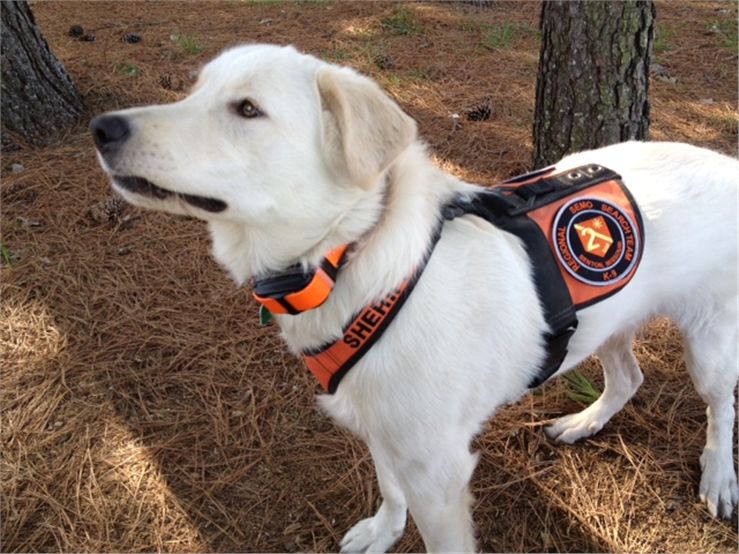
With the beginning of scent work coming up, I was considering making her a cadaver dog, rather than a trailing dog to lesson the stress during searches. When I told the doctor that I estimated that we would be working for only the next three of four years, he said she would not be affected in that short a term, and that Dutch could do anything for that period of time. So we are back to training for trailing. I know a lot more about about trailing than I do about cadaver.
Another thing that the folks at Extreme K9 noticed is that Duchess is a very soft dog, one that would respond very well to positive reienforcement and would not do well with any type of harsh correction. I had already suspected this early on, and all of her training this far has been positive reinforcement through marker training, and she has responded very well. The addition of the eCollar has given us just enough control during periods of high distraction, while enabling us to keep voice commands, praise and rewards all positive. We reinforce the marker training in some way every day to keep it fresh in her mind. That and a strong recall response to the audible signal on the eCollar, wil be the keys to the start of search training. Extreme K9 trainers said that runaways were not a recommended method of starting a dog of Duchess' soft disposition, and that I would need to come up with another method of matching scent source to trailing. This will be a major adjustment to the training method, but not the over-all plan. We are continuing the march.
Obedience at Extreme K9
After 8 long weeks travelling to Extreme K9 near Carbondale, IL, Duchess has finally graduated from their "Get Real" Obedience Class.
Duchess presents some unique training challenges, because she is a very soft dog with a strong desire to please.
She can also go from docile to panic in one swift step, if she feels ovewhelmed by her environment. That is a price you pay when dealing with a rescue from a shelter. You don't have a br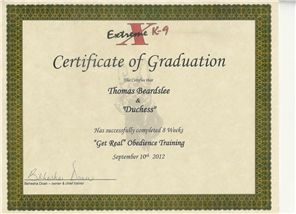 eeding history to fall back on, and you have to accept the hand that is dealt you, finding a way to communicate that is totally non-threatening and positive reinforcement. That meant on the first night, when I found the one of the training tools we would be using is the choke chain, I was concerned, and I mentioned that to the trainer, saying that all of Duchess' training so far had been Marker Training, and that I did not use correction collars. She said I would learn a way to use the collar, so that the dog was actually correcting herself. We spent the first night talking about how dogs learn, and how handlers can screw that up using the wrong methods. They also talked about the difference between their methods and the old "yank and crank" style of training, being used by many unenllightened trainers still today. We spend the rest of the first evening learning to "Load the Marker" which I was already familiar with, since all of Duchess' training to date had been marker training. The other tools required for the class eeding history to fall back on, and you have to accept the hand that is dealt you, finding a way to communicate that is totally non-threatening and positive reinforcement. That meant on the first night, when I found the one of the training tools we would be using is the choke chain, I was concerned, and I mentioned that to the trainer, saying that all of Duchess' training so far had been Marker Training, and that I did not use correction collars. She said I would learn a way to use the collar, so that the dog was actually correcting herself. We spent the first night talking about how dogs learn, and how handlers can screw that up using the wrong methods. They also talked about the difference between their methods and the old "yank and crank" style of training, being used by many unenllightened trainers still today. We spend the rest of the first evening learning to "Load the Marker" which I was already familiar with, since all of Duchess' training to date had been marker training. The other tools required for the class 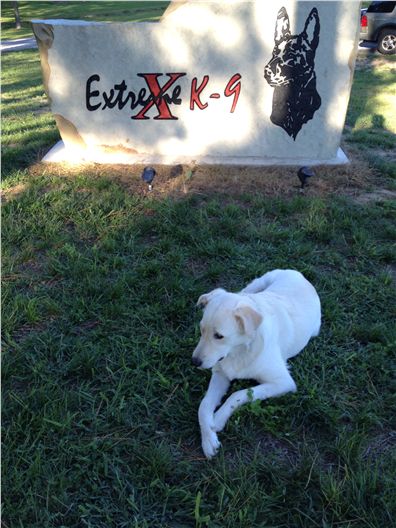 were a treat bag, and six-foot lead and a 15-foot lead. We also practiced going through doors, without the dogs bolting through ahead of us. This was a simple exercise designed to start the dogs paying attention to the handler, and deferring to what the handler wanted, rather than what the dog wanted. This was all positive reinforcement and correction collars were not used. were a treat bag, and six-foot lead and a 15-foot lead. We also practiced going through doors, without the dogs bolting through ahead of us. This was a simple exercise designed to start the dogs paying attention to the handler, and deferring to what the handler wanted, rather than what the dog wanted. This was all positive reinforcement and correction collars were not used.
This made me feel a little better, but I was still concerned about what we were going to use the choke collar for later on. Homework for that week was all marker training and establishing the need in the dog to pay attention to the handler. Something as simple as rewarding eye contact is the key here.
Needless to say we progressed from there, first on a 15-foot lead, then shortened to half that to make corrections more immediate, and making the dogs more responsive to the handler needs.
Some dogs took more correction than others. Fortunately, Duchess was already pretty attuned to my needs, and in the uncertain environment of a class with 12 dogs in it, she didn't stray far from my side from the beginning.
The training after that from week to week, included healing, learning to sit, down and stay, recall to a spcific place in front of the handler, staying with the handler out of sight (last night at graduation, we all down-stayed our dogs in a line and left the building for several minutes, then returned to our dogs, and not a single dog broke the stay, amazing).
Of course, there were the inevitible doggie dominence issues to be addressed throughout the course, which were handled swiftly by the instructors. Some of the dogs will take more work in that area, but since Duchess doesn't have an aggressive bone in her whole body, it wasn't issue with her. Except . . . when two or more of the dogs would get into it, and the noise level shot up, she would go from zero to panic in a fraction of a second, and fortunately her choice of what to do is seek cover behind her Alpha, and wait for the storm to blow over. Not like she did at Neighbor Day, when she headed for her crate in the DogWagon.
The Extreme K9 Campus, Carbondate, IL.
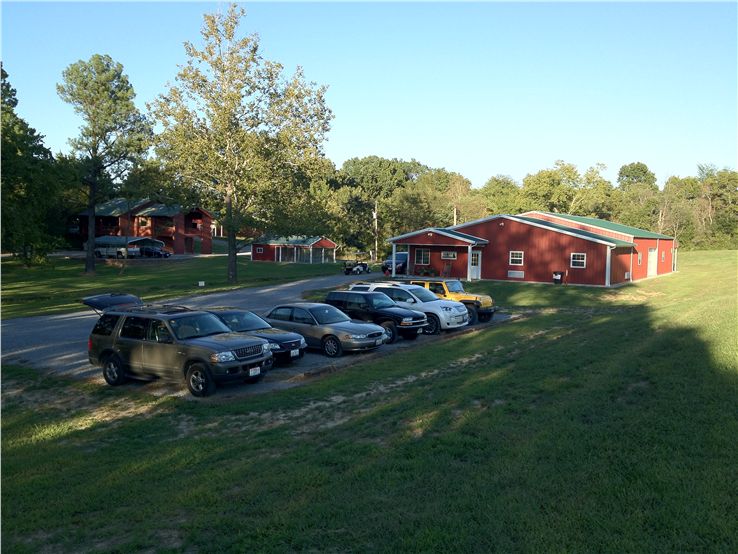
This is not my first rodeo with Extreme K9. Lady and I did a lot of training there, when I first got her. I have to attribute their guidance and help to being a significant force in making Lady the people finding machine that she turned out to be. Now, with Lady retired, I am hoping we can overcome Duchess' suspect lineage, and make her a productive member of the Search and Rescue Community as well. We have a great start with this solid obedience base. The next course will be the eCollar training starting next month, so she can work reliably off lead. She already knows a little about the audible aspects of the eCollar, but I want to achieve that solid base with it as well, so that when we finally get to scent work, we won't have to worry about the basic stuff. The question is, what kind of scent work is she going to do, and I have to say that there are many factors at play in that decision, and I just don't know yet. Time will tell. The Plan continues.
-
Basic Training ends, and Scent Work Begins
On November 21, 2012, Duchess completed eCollar Training, and with that, Obedience and her AKC CGC (Canine Good Citizen) certification completed, it is now time for the fun stuff (not that obedience training isn't fun, all time spent working with my dog is fun), that is scent work.
I discussed with the good folks at Extreme K9 what Duchess would be best suited for, and we all agreed that live-find trailing is the best bet for her.
Dutch does not possess the high (manic) drive necessary for drug or bomb detection. She is a soft dog and too laid back for that. HRD is not for us, because I enjoy the immediate gratification of finding a missing person before they need an HRD dog, and it is the type of training that I know best. Lady has a similar laid back demeanor, and it didn't stop her from being very good at finding missing people.
Scent work starts for us at Extreme K9 in early December, where they will get us started on the right foot, then it is Practice, Pratice, Practice, followed by repitition and some more Practice.
Some have questioned the methodical approach I take to training, and the time this involves. I have reminded the critics that obedience is the basis for all training. It is during obedience training that the dog and handler come to an accomodation as to who is in charge, and the handler learns how to teach that specific dog, and the dog learns how to learn. Without that solid base and 100 percent reliability before moving on, you have a dog that learns things on his/her terms and whose reliability is questionable. You also have a dog who, while they may possess some search skills, still require a pinch and a two hand grip on the lead to be controllable with other dogs and people, and who may never get the opportunity to use their skills in actual searches, because they can't pass the certification tests, all of which start out with an obedience test, and many of which require the AKC CGC to be allowed to test.
I prefer my methods and they have worked for me in the past. As I have often said, the proof is in the ability of the dog/handler team to find missing people. Certificates on the wall are nice, but they are the result of a controlled environment test, and don't necessarily mean the dog will "hunt (search)" in the real world.
Duchess' other job is being a good ambassador for search and rescue. She has already proved to be a great asset in that area. We have gone to community picnics and pre-schools, where she is a big hit with the kids, and displays a positive image of the search and rescue dog. We will expand on that this Holiday Season going to extended care facilities, to brighten the day of seniors. Lady was always a welcome visitor in these facilities, and I suspect Dutch will be the same. Again 100 percent reliability in obedience is a key during these visits, and Dutch has proven she is up to the task already. The Plan continues.
-
SCENT GAMES
All dogs have the ability to use scent to find things. It is a gift they have and they use this ability every day of their lives.
The change comes when a human enter's their lives, and wants the to use this capability to find something the human wants found, like another human. This makes it a communications problem. Without getting into a long discussion of scent theory and how dogs are able to do what they do, we will just accept that every dog is born with the ability to find things with their noses.
It has been my observation, having worked with another successful trailing dog, that dogs rely on all their senses to find things. When they understand what they are looking for, and can't see it or hear it, they go to the nose. It is in this area that they far exceed the human capability to locate things. Their noses are many thousand times more sensitive than humans, and have the ability to catagorize and recall scents.
The trick here is getting them to find what we want found, and the keys to this are the dog understanding what we want found, and the drive to find it. Unless both of these things exist, the dog will not be reliable at finding missing persons. This does not mean that they understand that we want them to find Billy Bob the missing juvenile. It means they have learned to follow a scent, which we will provide for them, until they find that person with the same identical scent, or until the trail runs out. And, they have developed the drive to push them to do that disregarding all other things, until it is accomplished. This is no small training task.
Our first sessions with Extreme K9 during Scent Games, are designed to develop a stronger drive, while training the dog to channel this scenting ability into what they realize is what the handler wants. Baby steps here are crucial.
-
Another Course Adjustment
With a rescued dog, whose history and breeding are vague at best, we often learn things about our partners that require adjustments in our plan. I am one of those folks who believes that when you partner with another (in this case, a dog) it is for life, for better or worse, and you adjust as needed.
I am finding that Duchess is such a "soft" dog, that trailing may not be in her future after all. Not that I am giving up on her, but it is going to take a lot of time and patience.
However, as they say in The Sound of Music: "whenever a door closes, a window opens somewhere else", and that is the case with Duchess. She is such a social dog, with an abiding affection for nearly every creature she encounters, I have decided to put that into practice and have her evaluated as a Therapy Dog.
We have already visited schools and pre-schools, a couple nursing homes and some community functions, and she is a big hit wherever she goes, and she shows an amazing restraint when in the presence of the very young and the very old. I believe this trait is a natural instinct rather than something that can be trained to the same degree.
Duchess seems to be uniquely suited for this very worthwhile vocation, that provides comfort for many who need it most. This will be the new direction for our training and we will advise how it goes. If you have an interest in Therapy Dogs, the AKC has a wealth of information about it at:http://www.akc.org/akctherapydog/
-
Another Milestone Reached
April 27, 2013 - Today Duchess passed her evaluation for Therapy Dog, and she will be affiliated with Pet Pals of Cape Girardeau ( http://www.semissourian.com/story/1739793.html ). At last count, this group has 24 dogs and handlers who go to hospitals and nursing homes to provide comfort for those patients or residents. After 50 documented Therapy Dog visits, Duchess will be eligible for the AKC Therapy Dog Title ( http://www.akc.org/akctherapydog/ ). 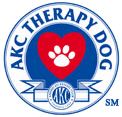
We are looking forward to these visits, not only for the joy and healing they can provide for those in need, but also to provide Duchess with a mission while we work on her live-find trailing training. Each visit will be a step toward her AKC Title (THD) and toward helping her progress in her trailing training, as well, through the contact with such a wide variety of people and situations.
Duchess turned two years old in April, and next week after her annual physical we will have the necessary paper work filled out for her first official Pet Pals visit.
-
THERAPY DOG PROGRESS
Duchess and I continue to work toward her TDH, with 19 visits in the books toward the 50 she will need for the AKC Title. In addition, we have discovered this her true calling, and we will continue making these visits for the remainder of our careers.
In addition to making progress toward her title, we have found that Duchess appears to enjoy the visits, and warms to those we visit without need for encouragement. She will go right up to everyone, whether they are in a wheel chair, on a walker, or sitting at a therapy machine.
I think she realizes the effect she has on people, and likes it. She is also a hit at community events. We had her at the Cape Air Show this year, where she met many people and learned to ride in the Gator.
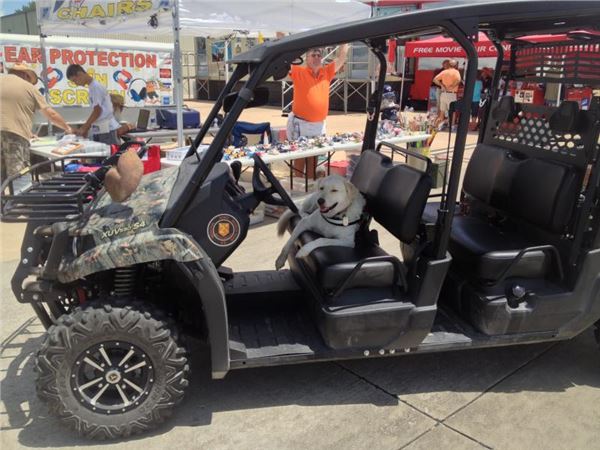
We are also working on becoming affilliated with state disaster response for deployment to disasters where Therapy Dogs are sent to comfort the sick, or injured, or displaced. There is currently no state-wide coordinator for Therapy Dog deployment, so this is still a work in progress.
Therapy Dogs have a real place in Search and Rescue and disaster response. At the end of the day, they can provide a valuable service to survivors, and the family and friends of those who did not survive. The SEMO Regional K9 Search Team is on file with the state mutual aid coordinator for SAR, and hopefully that will lead to deployment for Therapy Dog service as well.
To date, we have visited with several assisted living facilities, four schools, The Veterans's Home, and this month we are schedule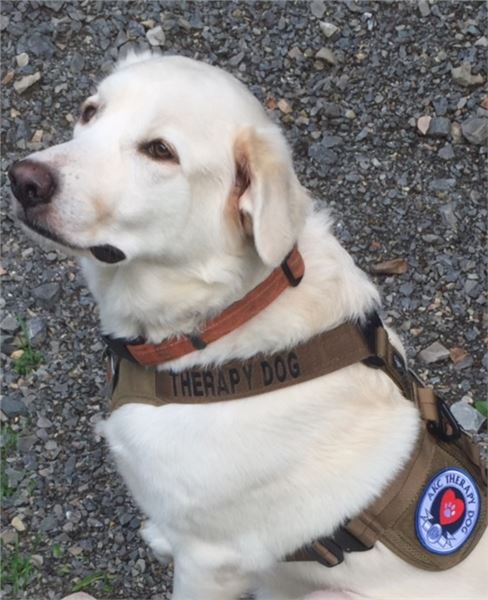 at a hospital and several other places. The Lauras Hurst at the Humane Society of Southeast Missouri Pet Pals, keeps us scheduled with assignments, and we come up with a few on our own. As the Holiday Season approaches, we intend to expand our horizons to the southern end of the county, with the intention of being at every nursing home and assisted care facility in the county. This weekend we are at Benton Neighbor Day to promote CERT (Community Emergency Response Team) training, and Duchess will get to meet lots of new friends. at a hospital and several other places. The Lauras Hurst at the Humane Society of Southeast Missouri Pet Pals, keeps us scheduled with assignments, and we come up with a few on our own. As the Holiday Season approaches, we intend to expand our horizons to the southern end of the county, with the intention of being at every nursing home and assisted care facility in the county. This weekend we are at Benton Neighbor Day to promote CERT (Community Emergency Response Team) training, and Duchess will get to meet lots of new friends.
TEAMWORK
Therapy Dogs are dogs who go with their owners to volunteer in settings such as schools, hospitals and nursing homes.
From working with a child who is learning to read or providing encouragement to the sick or injured, to visiting a senior in assisted living, therapy dogs and their owners work together as a team to improve the lives of other people.
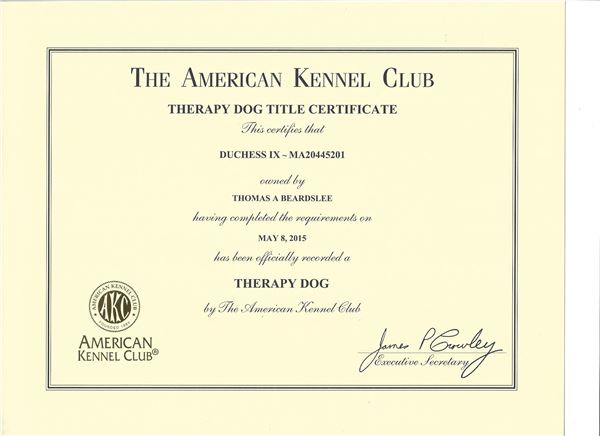
|